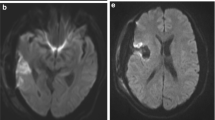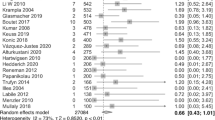Abstract
Purpose
The neuroimaging diagnosis of diffuse gliomas can be challenging owing to their variable clinical and radiologic presentation. The purpose of this study was to identify factors that are associated with imaging errors in the diagnosis of diffuse gliomas.
Methods
A retrospective case–control analysis was undertaken. 18 misdiagnosed diffuse gliomas on initial neuroimaging (cases) and 108 accurately diagnosed diffuse gliomas on initial neuroimaging (controls) were collected. Clinical, pathological, and imaging metrics were tabulated for each patient. The tabulated metrics were compared between cases and controls to determine factors associated with misdiagnosis.
Results
Cases of misdiagnosed diffuse glioma (vs controls) were more likely to undergo initial triage as a stroke workup [OR 14.429 (95% CI 4.345, 47.915), p < 0.0001], were less likely to enhance [OR 0.283 (95% CI 0.098, 0.812), p = 0.02], were smaller (mean diameter 4.4 vs 6.0 cm, p = 0.0008), produced less midline shift (median midline shift 0.0 vs 2.0 mm, p = 0.003), were less likely to demonstrate necrosis [OR 0.156 (95% CI 0.034–0.713), p = 0.008], and were less likely to have IV contrast administered on the initial MRI [OR 0.100 (95% CI 0.020, 0.494), p = 0.008].
Conclusion
Several clinical and radiologic metrics are associated with diffuse gliomas that are missed or misdiagnosed on the initial neuroimaging study. Knowledge of these associations may aid in avoiding misinterpretation and accurately diagnosing such cases in clinical practice.


Similar content being viewed by others
Abbreviations
- IDH:
-
Isocitrate dehydrogenase
References
Ostrom QT, Bauchet L, Davis FG et al (2014) The epidemiology of glioma in adults: a “state of the science” review. Neuro-Oncology 16(7):896–913
Alexander BM, Cloughesy TF (2017) Adult glioblastoma. J Clin Oncol 35(21):2402–2409
Perry A, Wesseling P (2016) Histologic classification of gliomas. Handb Clin Neurol 134:71–95
Parsons DW, Jones S, Zhang X et al (2008) An integrated genomic analysis of human glioblastoma multiforme. Science 321(5897):1807–1812
Yan H, Parsons DW, Jin G et al (2009) IDH1 and IDH2 mutations in gliomas. N Engl J Med 360(8):765–773
Brat DJ, Verhaak RGW, Aldape KD et al (2015) Comprehensive, integrative genomic analysis of diffuse lower-grade gliomas. N Engl J Med 372(26):2481–2498
Cancer Genome Atlas Research Network, Brat DJ, Verhaak RG et al. Comprehensive, integrative genomic analysis of diffuse lower-grade gliomas. N Engl J Med 2015;372(26):2481–2498
Eckel-Passow JE, Lachance DH, Molinaro AM et al (2015) Glioma groups based on 1p/19q, IDH, and TERT promoter mutations in tumors. N Engl J Med 372(26):2499–2508
Louis DN, Perry A, Reifenberger G et al (2016) The 2016 World Health Organization Classification of Tumors of the Central Nervous System: a summary. Acta Neuropathol 131(6):803–820
Ceccarelli M, Barthel FP, Malta TM et al (2016) Molecular profiling reveals biologically discrete subsets and pathways of progression in diffuse glioma. Cell 164(3):550–563
Patel SH, Poisson LM, Brat DJ et al (2017) T2-FLAIR mismatch, an imaging biomarker for IDH and 1p/19q status in lower-grade glioma: a TCGA/TCIA project. Clin Cancer Res 23:6078–6085
Claes A, Idema AJ, Wesseling P (2007) Diffuse glioma growth: a guerrilla war. Acta Neuropathol 114:443–458
Upadhyay N, Waldman AD (2011) Conventional MRI evaluation of gliomas. Br J Radiol 84:107–111
Villaneuva-Meyer JE, Wood MD, Choi BS et al (2017) MRI features and IDH mutational status of grade II diffuse glioma: impact on diagnosis and prognosis. AJR Am J Roentgenol 20:1–8
Huisman T (2009) Tumor-like lesions of the brain. Cancer Imaging 9:10–13
Cunliffe CH, Fischer I, Monoky D et al (2009) Intracranial lesions mimicking neoplasms. Arch Pathol Lab Med 133:101–123
Boulter DJ, Schaefer PW (2014) Stroke and stroke mimics: a pattern-based approach. Semin Roentgenol 49(1):22–38
Posti JP, Bori M, Kauko T et al (2015) Presenting symptoms of glioma in adults. Acta Neuropathol 131(2):88–93
The UK TIA Study Group (1993) Intracranial tumours that mimic transient cerebral ischaemia: lessons learned from a large multicentric trial. J Neurol Neurosurg Psychiatry 56:563–566
Li L, Yin J, Li Y et al (2013) Anaplastic astrocytoma masquerading as hemorrhagic stroke. J Clin Neurosci 20(11):1612–1614
Itri JN, Patel SH (2018) Heuristics and cognitive error in medical imaging. AJR Am J Roentgenol. https://doi.org/10.2214/AJR.17.18907
Tversky A, Kahneman D (1981) The framing of decisions and the psychology of choice. Science 211:453–458
Bruno MA, Walker EA, Abujudeh HH (2015) Understanding and confronting our mistakes: the epidemiology of error in radiology and strategies for error reduction. RadioGraphics 35:1668–1676
Wurm G, Parsaei B, Silye R et al (2004) Distinct supratentorial lesions mimicking cerebral gliomas. Acta Neurochir 146:19–26
Author information
Authors and Affiliations
Corresponding author
Ethics declarations
Conflict of interest
The authors declare that they have no conflicts of interest.
Ethical approval
All procedures performed in studies involving human participants were in accordance with the ethical standards of the institutional committee and 1964 Helsinki declaration and its later amendments or comparable ethical standards.
Informed consent
The requirement for informed consent was waived by our institutional IRB for this retrospective study of patient data.
Electronic supplementary material
Below is the link to the electronic supplementary material.
Rights and permissions
About this article
Cite this article
Maldonado, M.D., Batchala, P., Ornan, D. et al. Features of diffuse gliomas that are misdiagnosed on initial neuroimaging: a case control study. J Neurooncol 140, 107–113 (2018). https://doi.org/10.1007/s11060-018-2939-9
Received:
Accepted:
Published:
Issue Date:
DOI: https://doi.org/10.1007/s11060-018-2939-9




